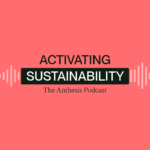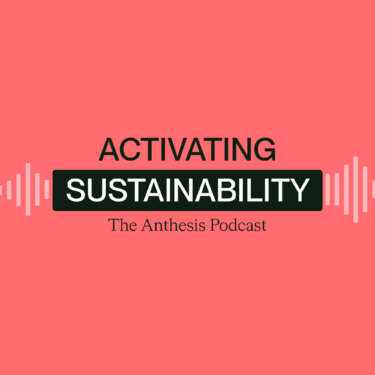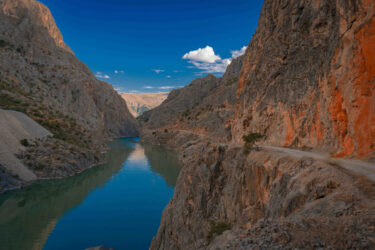
Speakers
Chris Peterson, Director
Stuart McLachlan, CEO
Dean Sanders, Chief Enterprise Officer
Related Topics
Share this episode
In this Activating Sustainability episode, our host Chris Peterson is joined by Stuart McLachlan, Founder & CEO, and Dean Sanders, Director, to discuss their recently published book: The Adventure of Sustainable Performance: Beyond ESG Compliance to Leadership in the New Era.

Read the transcript
Chris: Hello, and welcome to Activating Sustainability, the Anthesis podcast. I’m your host, Chris Peterson. It has been a very exciting last few months for Anthesis. At the end of June, we announced that global investment firm Carlyle has agreed to acquire majority stake in Anthesis as we continue to drive positive impact through developing and activating sustainability strategies. And on that note, I’m joined today by our guests, Stuart McLaughlin, CEO of Anthesis, and Dean Sanders, a director at Anthesis, to discuss their new book, The Adventure of Sustainable Performance, Beyond ESG Compliance to Leadership in the New Era. Thanks so much for joining.
Stuart: It’s a pleasure. Good to be here, Chris
Dean: Great to be here.
Chris: Well, maybe to jump in, I’d love to hear what made you want to write the book and why now?
Stuart: So I think it’s fair to say that this publisher, Wiley, had approached us on a number of occasions about writing a business book made the subject of sustainability or what we then started to call sustainable performance, accessible to business leaders, taking an interest in sustainability in the past, but also for those business leaders who were just having to sort of approach the subject for the first time and to try to bring it to life and to make it much more accessible. And I think that the first sort of instinctive response was that we hadn’t actually considered writing a book, and so it wasn’t on our list of priorities. And secondly, we were pretty limited when it came to time available. So, after I don’t know how many times they approached us, because they’d obviously seen all the amazing work that’s done at Anthesis and thought, how can we bring that to life in the form of a book? And how can we bring some of those experiences of Anthesians and the class that they serve to life? We said, well, OK, let’s give it a go. And the publisher suggested all sorts of ways by which they could support us and to bring writers to help us and all that kind of stuff. I mean, in the end, we signed up to a contract, which turned out to be about 10 months to decide on the book we wanted to write and then two months to actually write it. Is that correct?
Dean: I think something along those lines, Stuart. I think perhaps the ‘why now’ part of the question is really interesting, Chris, in the sense that the two things that have come together, I think in Stuart’s case and in my case, is that we’ve each been working in this space for quite some years. I think at some point in the book we mentioned the fact that our combined span in this profession is roughly equivalent to the average human life. So we felt as if, frankly, we did have something to share. There was an accumulated experience that we think is a great example. So we’ve met some interesting people doing fantastic work. So we felt that we were able to share that and wanted to share that. And of course that coincided with this sort of tipping point that I think we see ourselves in right now where perhaps accelerated by the forthcoming legislation and regulation that’s coming in Europe and in North America and other jurisdictions. That time was really interesting in the sense that we feel that there is something important to share and that this is a moment where leaders are taking note because of the various pressures that they are under. So that coincidence does feel actually quite fortuitous for us. And we hope it means that leaders will look at this and it will help them approach ESG and sustainability in a different mindset than they might not have done had we not had the chance to get this out there. So that would be my thought. But yes, it was quite an accelerated journey, and it was for the record on top of the day job.
Chris: Yeah. I don’t know how much is on your plate, so that idea of like, why now, is really helpful. So appreciate the perspective. And I know you’re going into much detail around this and some of the terminology, I like the approach. You mentioned, Dean, that draws on that story of canoeing under elephants. I’m wondering maybe if you could speak to that so that we can anchor that and some of the conversation we’ll carry forward.
Dean: Well, I think that’s Stuart’s story, so we’ll let him tell the story, but I’d love to sort of pick up on why we think a metaphor is an interesting way of framing the content that we collected in the book. But Stuart, it was your experience, so please do share.
Stuart: I think this is against the backdrop of sort of growing recognition that we’ve had, you know, the old era that was devised at the end of the Second World War is coming to an end and that we’re entering this sort of transition period and that leaders have got to go on a journey and they’ve got to take their stakeholders with them on that journey. And as they step out of the sort of model systems, what we call in the book the strongholds, that have been built in the previous era into this transition zone, recognizing some assets are going to be stranded, some assets are going to be of value and need to be stewarded with them across this transition. That it’s a place of peril and jeopardy and excitement and opportunity and all those kind of things that go with a great adventure. And probably the main reason why we landed on the title of the book that we did in terms of the adventure of sustainable performance, sustainable performance being that sort of destination place that actually hasn’t been designed yet. But at some point in this transition zone that we’re stepping into now, we have to get beyond the sort of the paralysis of the client’s stage that so many organizations and leaders are in at the moment into a place where we recognize that there’s fantastic opportunity for the creation of new value and to reimagine and redesign the monitoring system to the next era. So that’s a journey and we have framed it in the context of this adventure. And then, I mean, slightly by chance, to be honest, but we came up with a metaphor. I was sharing an experience that my wife and I had had when we went to Zimbabwe some years ago, and we went camping on the banks of the Zambezi. And on the first day, we went out with our guide, just the three of us. And we’d done this a few times before, where we were just sort of walking through the African bush and fairly relaxed. But on this particular occasion, this massive bull elephant crashed out of the bush in front of us and took one look at us and ran off. And I remember saying to the guide, well, that was a bit close. And he just said, stand behind me, say nothing, and be still. And so that’s what we did. And we watched this elephant and it ran off and it got to about 130, 140 meters away. And then it turned around and charged at us. And it got faster and faster and the noise it annoyed it, it was trumpeting and it was waving its ears and it got to within about sort of 30 to 40 meters and this guide, all the way through this time that it was chanting, it just said, stay still, keep behind me, say nothing. And it got to about 30 to 40 meters and the guide put his gun above his head, not with any intention of using it, and just walked up to this elephant and shouted, foot sack, which is a disrespectful Afrikaans term for go away, and the elephant spit it all and ran off. So from that point on, kind of everything changed in terms of the way we viewed that kind of natural environment. And we went back to the campfire that evening and we sort of reflected on this and sort of chewed over our relationship with nature and how we recognised that for most of our life we are in a place where we are controlling nature. And then in this particular instance we recognised that actually we were in the natural world and the natural world was in charge. Perhaps that was the first time in our lives where we recognised that we had stepped into a different relationship, a different partnership with nature and we had to respect it in a different way. The second day, day two, we took some canoes up the Zambezi and we canoed down the Zambezi and we were canoeing down and there was a herd of elephants in the side of the river and the guide, same guide, the three of us, he said, right, we’re going to canoe in underneath the elephants. We said, you’ve got to be joking, I’ve got to have an S today. And he said, no, they’ve never been threatened by anything that comes to the river, so they’ll be completely relaxed. So sure enough, we canoed down under the elephants and they were pulling the weed out from the sort of shallows of the Zambezi and putting the weed in their mouth and the water was pouring out of the mouth over our heads, so we were literally that close. And they were totally relaxed. And it made us realize that if you re-approach these incredible animals and nature in a different way, you can have a completely different experience. So day two was full of opportunities, full of enrichment, full of excitement, the right kind of excitement. Day one, paralysis. Day two was full of opportunity, excitement and enrichment. As I was sharing this story, Dean and one or two others that were with us at the time said, hey, doesn’t that sound like the kind of metaphor we should use in the book? Because most of the world at the moment is in day one, the paralysis of the charge, with all the regulations, all the stakeholder pressure and all the attention and all the litigation and everything. And the paralysis of the charge associated with the issue of sustainability, climate impact, whatever you want to call it. And we need to reflect on that. We need to get around the campfire and really explore what’s happening here. And then get to day two. Get to day two. Because when we go on this journey, we need people to recognize that actually, if you comply well, and let’s not belittle the importance of compliance because you’ve got to survive that and you’ve got to comply well and efficiently. But on the other side of that, there is incredible opportunity. And so that’s the way we ended up structuring the book with sort of day one, campfire, day two, and tried to then bring lots of examples in as to resonate with the readership.
Dean: I think building on that, I mean, Stuart was telling us a story and it was just as he was recounting that story that we thought there is a narrative opportunity here. And as you know, Chris, recently as we’ve made an acquisition of our first creative agency, which really excels in taking ESG content and sustainability and framing it into stories, we know the power of storytelling. I’m sure that when the publisher first came to us, they would have been very happy with a book titled ESG for Beginners or for Dummies or all the other sort of titles that one sees, or just an ESG manifesto. There were some key words that they wanted in the title, and we said, sure, we’ll put those in the subtitle. But we want to write about the adventure of the work that we do, that to rekindle that spirit in leaders of being pioneers and sort of taking their organisations on journeys. And so, that was really important. We heard that story before. There’s a way of kind of expressing what it is we want to get across to the audience by using a narrative framing device. And that’s not uncommon in business books. You’d be familiar with sort of Blue Ocean Strategy or the Infinite Game or Competing for the Future. And these kind of, you know, this is not just a handbook. This is much, much more than a handbook. This is a, there are elements of a handbook in it, there are sort of blueprints for guides to take leaders on that journey, but there are also stories of hope and excitement and enthusiasm and there’s a reality check about day one as well. And I think we really believe, to your question, that canoeing under elephants as a metaphor and as a thought is a potentially bigger idea for us at Nthesis, is that we want to get people involved in a movement which is, we want the world to be canoeing under elephants and not terrified and in reaction and in paralysis, to use Stuart’s phrase. So we really do hope that this is beyond the book, something more compelling as a thought and an idea that we hope to seed with people over time.
Chris: Yeah, no, it’s really exciting to see and to have that type of the language around, right? So appreciate you kind of walking through that. There was a tone throughout the book and Stuart and Dean and your comments around this concept of ‘have to’, right? And I’ve heard that a number of times today and again throughout the book of, this is something that leaders have to do. Wondering if maybe we could speak to that a little bit before we get into some of the concepts and stories.
Dean: Yeah, it’s a great question because I think that in some sense we were at an event recently with a whole bunch of ESG leaders, it was a one-day event and it was hosted at a legal firm where actually the lawyers had the first item on the agenda and they just went through the relatively sort of never-ending list of acronyms that are suddenly becoming have-tos. Sustainability and you know when I first set out 25 years ago corporate responsibility, now ESG, whichever terminology we use has been an opportunity and a choice for leaders all the time. I mean and some great leaders and visionaries admittedly in most cases or in many cases not companies that were particularly at scale but the ones that we all know and love, the Patagonias, the Body Shops, the Ben and Jerry’s, those really exciting entrepreneurs who wanted impact as well as performance in their business. I think that that choice was there. And in some cases at scale, when we look at the work of Paul Bollman at Unilever, and I think, again, it’s something that we derive a lot of inspiration from those examples. But the reality is that, in practical terms, too few leaders chose that option. And so this regulatory framework that’s now kicking in is the have to because the carrots are no longer really being dangled, it’s the stick that’s come out. And so we’ve got to get on with it. And I think there is a real sense, my colleague and I were just presenting an ESG upskilling to a board of directors of a multinational company here in Europe and the executive committee of that company which was all about what do you have to do now, what is coming, there’s no choice, this is the elephant charging at you in one sense. But we managed in that conversation where the choice still resides I think is in how are you going to, it’s just sort of what we’re looking for is there is a whole bunch of compliance and regulation coming that you have to adhere to, but to what extent can that also help catalyse you or move you towards something more exciting towards day two. I think we don’t really, we know we can help our clients and we must and we will help them to wrestle with the various legislative pressures that are coming and they are different by jurisdiction. And we need to do that efficiently and wisely and well, because if you don’t get through day one, as Stuart said, you won’t even get to the campfire. You certainly won’t get to day two. But we want to be doing, I think there’s a good quote in the book from the CEO of Nespresso who talks about, yes, we understand that we need to comply, but every new requirement for compliance may be an opportunity for us to perform or to innovate or to do something a bit different. I think it’s very much certainly in the work that I’m doing with that mindset that I want us to go into leaders is to say, yes, and not just you have to do this and tick a box.
Stuart: As both Dean and I have mentioned, the big stick of compliance is out. So we’re through this phase that actually we’ve been in probably for 20 to 30 years where organizations, the leaders of those organizations have decided that they’ve got a choice as to whether they step into the reality of what’s going on and lead their organization in response to a crisis that hasn’t just appeared in the last three or four years it’s been around for decades. I mean I was brought up in, I remember Margaret Thatcher giving a speech to the United Nations in New York the day before the Berlin Wall came down saying hey climate science is real and the world’s got to decarbonise. I mean it’s been around for a long long time. But there is no doubt that the world has woken up to the reality of this crisis in the last three or four years. And as a result of that, now we have a rapidly changing regulatory landscape. Because it’s no different to, for example, the pandemic, where we had to do certain things. We had to allow ourselves to be locked down. We had to follow new rules, whether it was wearing face masks or whatever it might be. We had to follow new rules because we needed to lighten the load on the health system. And now we have to follow new rules because we have to lighten the load on the planetary system. And, you know, we came up with a new economic model in the pandemic called furlough. And I know the US, UNO, which is a name which I’ve forgotten just for a moment, you will probably remind me, but in Europe it was it was predominate furlough in the same way as now we talk about donut economics or we talk about the economic model of Mariano Mascato, we need to bring more balance around the rate at which value is created versus the rate at which value is extracted, you know, so but these are all models and systems for the transition in the same way as we had to get through the pandemic. So we need to get through this crisis and this crisis obviously is a planetary level, it’s a bigger crisis, but you know, we need to do certain things. And so that is why we are seeing now such a rapid response because obviously we can see what’s coming down the pipe. We can just see that the avalanche of regulation is just going to increase for the foreseeable future.
Chris: Yeah. No, it’s fascinating to see how it is all adapted over the time, right, that we’ve all been engaged in the space and to see it starting to come together. Dean, you mentioned that there’s lots of elements in the book which provide that guidance and how-to insights. And in particular, I love a lot of the language that was applied throughout it, whether that’s ERA’s strongholds, leadership, the pivot, the campfire, et cetera. We’d love to hear from both of you. Is there a concept or group of concepts that you feel is misunderstood, really critical for people to get their heads around just to give them a taste of what’s in there?
Stuart: Yeah, I’m happy to kick that one off, Chris. I think good to hear that you see lots of different thoughts and ideas and concepts in the book, even around this kind of very central core organizing idea, which is the reality of now and the challenge and the threat of a new relationship with nature and a response to that being this compliance that we’ve been discussing. I think that the chance to rethink and to launch into day two, I suppose I’d take two. I think the campfire is an amazing moment and an amazing opportunity. And you can take from that microcosm of the experience of that sort of two days, the campfire is an ongoing opportunity for leaders to reflect on what leadership means for them, who they are, who they are becoming, where they want to go personally and professionally with the organizations that they’re responsible for and the assets that they’re responsible for. So I think the sort of time to sort of almost take time out to get some perspective and distance, not easy for leaders, because this is just one of the aspects that they’re dealing with. And as we know, the executives in any organization, be it private sector or foundation or public sector, you know, people are busy. It’s complicated and it’s complex, but there is a requirement here I think just to have the chance to take a different perspective on the situation before you get stuck on this Groundhog Day, Hamster Wheel kind of experience of day one because the compliance agenda is there and you have to keep filing reports year after year after year. Is that what you came into Enterprise to do? Is that fulfilling you? Is it fulfilling your people? Is it attracting people? Are you retaining your talent, are you fulfilling your potential as a leader in that. So I definitely think that the campfire is a critical thought in the book at that moment between the two worlds of day one and day two. What I’d also say is what I think fascinates me is day two, and one of the things that really occurred to us as we interviewed those sort of people who were born into day two, those canoers who weren’t even aware that it was a day one in a sense, is the excitement and the energy of creating the solutions, the integrated sustainable performance solutions to many of these challenges. It’s almost not to be burdened by the compliance, but to be excited by the solution. And I think one leader in particular that I would call out is Sam Alimia who is the founder of C1 Ventures who is setting up a VC fund to invest in technologies that many of us have yet still to hear of, or some of them are already scaling, some of them are still quite early stage. But I find that whole idea of capitalising on understanding the exciting opportunities to create organisations that will address these problems rather than to come in with a tick box day one mindset. So for me I think the two things, campfire for all leaders, the energy and the excitement of day two, even for someone with 25 years experience in sustainability, I am very excited about day two, for myself, for Anthesis, for the next generation, and for the leaders that are coming through. I think Day 2 is just full of hope, opportunity, excitement and adventure.
Stuart: Yeah, I hope the book is a little bit Shawshank-ish. And I say that having sort of watched Shawshank with my 50-year-old boys just recently, and it’s a pretty tough watch because the horror of the experience, and you’ve almost got to go through that, you ask, especially when you are watching it with your son, how much of it feels like it is gratuitous and you get to the end and you realise you have to be taken through all the horror of that experience to be able to get through to the incredible hope and joy and release and liberation of the ending of it. Hopefully that is not a spoiler for all those people listening who haven’t watched it. But anyway, we start the book with rooting it in the reality of now, and we do feel that you’ve got to go through that, and you can’t just gloss over it. You’ve got to go through that, but we hope that as the book continues that we build up this hope. I’ve said to my kids, what a time to be alive, because for most of my career, I’ve had to work in broken models and systems, and make the best you can, knowing that they are broken. And now actually those models and systems are breaking down, now the next generation has got the opportunity to fix it. It might feel uncomfortable, it might feel a little bit scary and full of jeopardy, OK, that’s the transition zone. But be positive, be hopeful, be excited, because now you can reimagine something much better. And I take it back to, you know, if you go back through history, you can see these different eras and how they’ve been built up and broken down. And the one I’m particularly fascinated in is the end of the slave trade. We had an era that was developed, strongholds were built based upon the models and systems associated with the slave trade. And we give the credit to William Wilberforce and the Clapham sect for the work that they did in that 30 year period to bring the slave trade to an end. And effectively that was their transition zone, between when one era comes to an end before another era starts. And you can see the way they operated and the type of leadership that they embraced at that time to be able to force the strongholds of the old era to crumble. And of course they’re all the same stories, they all had to say yeah you know they might be a bit broken, it might be wrong, it might be unethical, et cetera, but what we’re doing is, when we become wealthy, then we’ll try to compensate in some way through philanthropy, through charity, but actually the core model is wrong, the foundation is wrong, if business is operating the way business should operate, you shouldn’t need all this philanthropy over here. And actually, it’s not in the book, but that’s why this podcast becomes extra special because we’re giving more information here. If you look at what happened in preparation for William Wilberforce, you had the Quakers who for 30, 40 years were demonstrating to the world that you could operate business, you could grow business successfully in a different economic model. And so, round trees and cabarets and barclays, bank and boots, et cetera, I know they’ve changed a lot now, but they were all Quaker businesses that started at that time. Incredibly successful. Operating outside the economic norms of the prevailing model to be able to demonstrate you can have success. And we see that now. What we are trying to do is pull out those kind of examples in the book to be able to demonstrate, hey, you can actually be successful operating in a model that looks more like a model of sustainable performance. Pulling on all that kind of excitement you just heard Dean talking about in the transition zone, starting to bring those in the way you do business to inspire then others to change more rapidly, just as the Quakers did in preparation for William Wilberforce to be able to then deliver the change that then happened at that time in history.
Chris: That’s perfect segue, because I was going to say there’s so many kind of inspiring stories, interesting stories, examples, case studies, et cetera. We’d love to hear, is there one or two that stand out for each of you in terms of the one that’s providing that inspiration, that hope, is it C1 Ventures, is it some of the other examples you speak to?
Dean: Yeah, I think for me, it’s interesting, isn’t it? Because I’d like to say it was all of the day two folks, but I think what I find, I’ve been working with the Nespresso business for a few years now, and through our partnership now and the integration of the Charlescannon Agency, we are working together on telling the impact story of Nespresso. And every time I go back into that and look at the way that that business, under the leadership of Guillaume Lecoeuf, I think, is always asking questions of compliance and thinking how can we make that work harder for impact and for performance in an integrated way. I mean, I can just, again, I’m not sure whether we illustrated that in that level of detail in the book, but in the coffee sector, there are a lot of voluntary standards and there’s a lot of voluntary compliance with those standards. Standards like Fair Trade and like Rainforest Alliance are really good standards. But they’ve become quite generic. In fact, we had Santiago Galan, the CEO of Rainforest, talking to us recently in the London office. And what he’s now trying to do with that organization is to take it further. Because in some sense it’s good news, the certification, which was at one point quite differentiating, has now become quite generic and quite sort of table stakes. But what we did with Nespresso is we connected that the rainforest standard with the Nespresso quality standards that we created a hybrid, something that only Nespresso had, which adhered to the generic sustainability standard, but just did something a bit different, which was a important kind of component on Nespresso, which is we are Nespresso quality with rainforest sustainability. So I think, and that was 20 years ago, and I think this idea of looking at standards and sort of generic compliance through a lens of thinking through how does that work for my organization? Do I just want to tick their box or do I want to have a conversation? And similarly, what Nespresso has done with Fairtrade is to take some of that premium and say, how can we solve some problems related to climate change, like crop insurance for smallholder farmers or retirement savings schemes. How can we work together to deploy that capital that we’re transferring upstream in value chains to be really meaningful in terms of some of the upcoming risks related to climate? So I really like what that organization has done in terms of integrating compliance with performance, which I think is a really critical element of what we need to be doing collectively.
Stuart: I have to say that when I look back with hindsight in terms of why write a book, the opportunity to speak to so many inspiring people that the book allowed us to speak to was probably as good a reason as any. So I’m going to go a little bit home team. So I’m going to talk about René Tout from Climate Neutral Group. group and one of the things I find particularly alarming is the agriculture system and how we’ve industrialized that, intensified it and the short-termism associated with it. So when I look at the work that René and the team are doing in South Africa and in Latin America, what we’re experiencing is that over the last 50 years the particular form of agriculture that most of the world is pursuing has stripped about 60% of the nutrients from the soil. And the reason why that is, is because the stronghold that businesses tend to operate in, where suppliers are deemed to be external to the corporate stronghold and where buyer leverage is used over supplier leverage to get higher yield at lower cost year on year has led to farmers being told that the only way that they can achieve that is to throw more chemicals at the soil and every time they get a yield, that’s for sure. They might be struggling now to get a high yield year after year, but nevertheless it’s kind of worked for a long that period of time. But of course we’re stripping nature at the same time. So there were land is becoming more and more dependent upon chemical use and what we’ve been able to do is use the intervention of climate finance.To be able to go to farmers and say OK if you farm ethical way, if you if you leave that intenser form of farming behind and you farm in a more regenerative way, then we can unlock the value of this climate finance and we can make sure that you are compensated for the risk that you might be taking and the first cohort was maybe 30 to 40 farmers and over a period of two to three years now you can see that actually the grasslands or that that particular patch of land is so much healthier because they’re farming regenerative way and actually their yield has gone up.The yield is gone up, and not only has their yield gone up, but they are now about to get the contribution that comes from those climate finance mechanisms. So they’ve got an alternative form of income and that alternative income is coming from corporations who are typically not in that food system but are effectively saying OK we need to buy offset, we need to buy some bonafide carbon credits at the high quality end of the market obviously, which these are. And so there’s an alternative form of income that’s coming from climate finance which is effectively breaking that old model. And that now means that buyer-supplier leverage conversations are now disrupted and that puts farmers in a position of growing power within the value chain.What does that do? That means that the leaders of organizations are now starting to realize they need to see their businesses ecosystems.So they need to get their arms around the full value chain, including their supplies and become more dependent upon the loyalty that comes from having a value respectful relationship with your suppliers as opposed to trying to use your leverage to exploit them, year on year. So we love those kind of interventions and those kind of.Disruptions that we are, we are starting to see where we see a soft benefit, we see environmental benefit. We also see what we believe is going to be benefit to businesses in the long run.
Chris: Yeah. No, it’s amazing to see that excitement and that total value structure as you outlined in the book. So maybe one final question for the two of you. What will be a key insight lesson or action that you hope people would take from reading the book?
Stuart: To step on the journey, step out on the journey. Recognize that actually you have no choice for that.You need the right guides around you, you don’t actually need traditional consultant. Traditional consultancy is a stronghold as well.That is a broken model.You know, you don’t need a consultant. There’s just gonna rock up and say, you know, here’s a consultants report. Good luck. And then leave, leave you to it. You need guides. You need people who gonna come alongside you, not just with the right advice, the right expertise to say, hey, they’ve travelled some of the journey, they kind of know what’s ahead of them, you know, with that kind of experience, but they’re gonna come along with the like equipment.And not strip the capacity and the capability from organisations into the consultancy company, but to empower organisations and to build capacity within those organisations, to be able to go on the journey themselves and they need guides, knockoffs, they need guides to be alongside them all the way and that changing relationship that organisations need to have.With companies like Anthesis as they step into the transition zone and recognise the peril and the opportunity of this journey that they’re now on and have no choice but to be on.That that is the bravery and the courage and the excitement and the opportunity and everything that we talked about through this podcast. You know, that needs to feel that kind of action. That is the one I hope that will come from people reading the book.
Dean: Yeah, that’s great. Yeah, I mean, just building on that, Chris, I think that I might always sort of distinguish between two audiences versus our own people at Anthesis.Our fellow Anthesians, I think that I would love for us to see ourselves as these. I think the term that there’s a sort of term is beginning to develop around being activated guides, which I love. We’re not consultant in that sense that Stuart was just alluding to that we’re sort of always looking to extract value from our client partners and all those that are sort of outsourced that to us, we’re looking to equip, empower a company on that journey. So I’d love this to be a sort of call to action to each of us to just improve our own capacity and capability. To speak to myself, I think it really became clear to me that the power and usefulness to organisations is to have people there for them with them or the journey is activated guides. So I, you know, I definitely would encourage those of you who’ve had a chance to sort of get hold of a copy of this book. If you do. Chris, thank you for having read through it. I’d love us all to get into that mindset and attitude of being activator guides for our planet. Second audience is our client partners and I think periodically in business literature you know books come along that remind leaders that there is something adventurous and exciting and special and precious about being a leader. I think there’s also just having vision and being determined. I think one point, we talk about entrepreneurship and spirit and grit and it’s not always easy building teams you can inspire, but who also are with you in that journey, I think I’d just love for people who are responsible for significant assets, big organisations, as I say, be they private sector, public sector or nonprofits, to sort of rethink their roles as we all collectively pivot from where we’ve been to where we need to get to. So if they can take some encouragement about the benefits and the opportunities of true leadership .Because I think that’s what we’re talking about, the new leaders in the new era. Then we would have, I think, served the purpose.
Chris: Wonderful. What a great place to leave it off. Thank you both so much for the time and insights today, for the language coming out of the book, all the inspiration, you know the real excitement around kind of the leadership opportunities in day two. So thank you both so much, I appreciate it.
Dean: Thank you, Chris.
Stuart: Thanks, Chris.
Dean: We’ll look out for your review on Amazon.
Chris: And thank you for listening. You can access Stuart and Dean’s book The Adventure of Sustainable Performance in hard, and e-copies in all the usual places, and we’ll provide a link to that in the meeting notes. Thanks again and keep well.
Inside this episode
- Reasons behind writing the book.
- The story behind “canoeing under elephants”.
- Key guidelines and concepts the book outlines.
- Extra insights from the authors not found in the book.
Find The Adventure of Sustainable Performance: Beyond ESG Compliance to Leadership in the New Era on Amazon.
If you have any feedback on the podcast, get in touch with our host Chris Peterson at: Chris.Peterson@anthesisgroup.com















